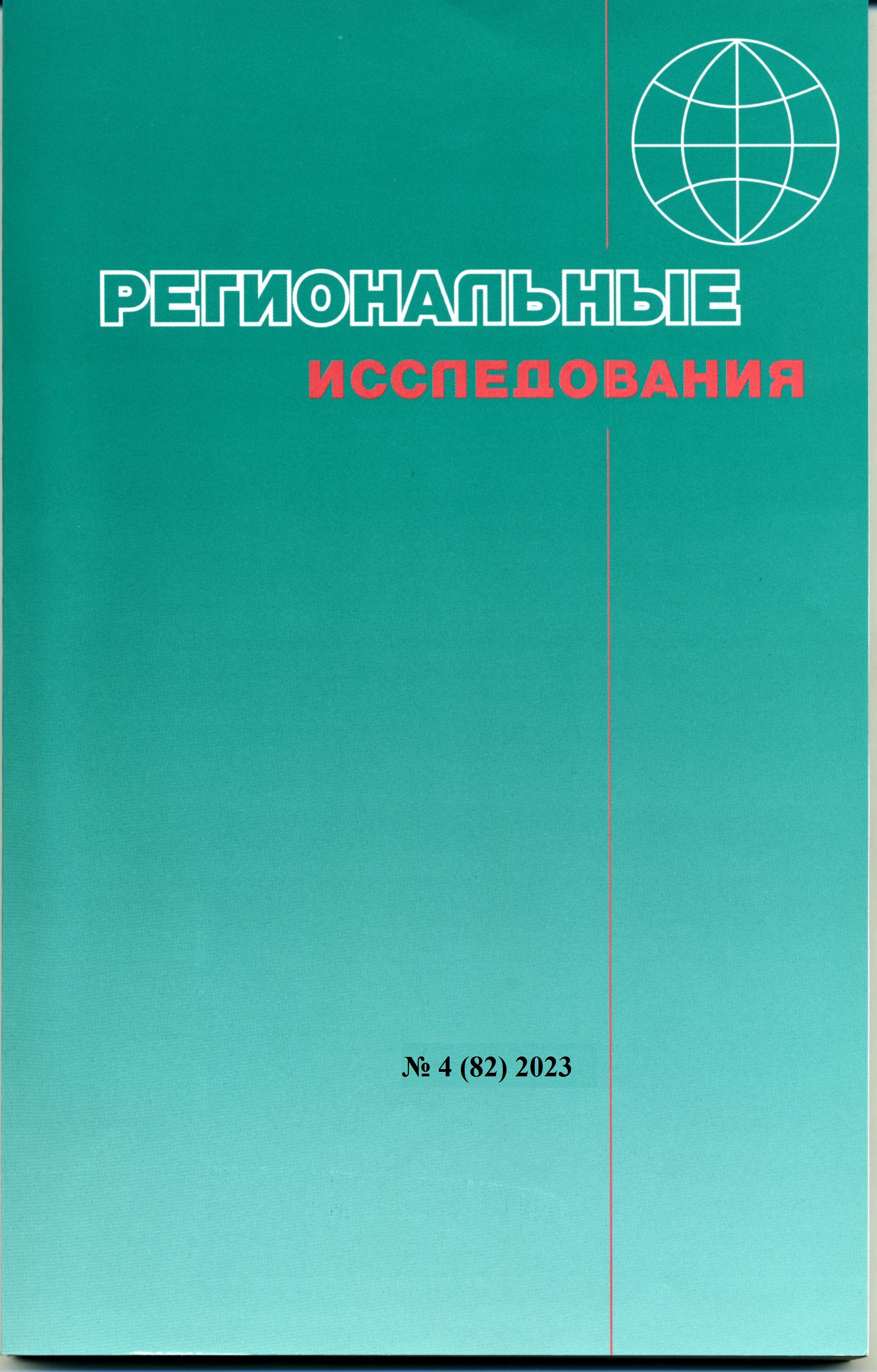Danshin A.I., Radikevich A.V. Comprehensive assessment of the development of agriculture in the Russian-Belarusian borderland
DOI:
https://doi.org/10.5922/1994-5280-2023-4-6Abstract
The main goal of this work is to search for new approaches to the study of agriculture in territories within which there are contrasts in the level of agricultural development in particular and the level of socio-economic development in general. The work uses methods of gravitational fields and economicgeographical profiling along the conventional line Minsk - Moscow, and also tests for the current state of agriculture the approach to assessing the agricultural specialization of territories, first proposed by I. von Thünen. The level of agricultural development, assessed using these methods, is presented in ten-year dynamics. The use of these methods made it possible to identify both poles of agricultural growth and depressed areas that lag behind in terms of the level of agricultural development and require the use of special instruments of institutional and socio-economic policy to support the agricultural industry. As a result of applying profiling techniques and building potential models within the Republic of Belarus, it was possible to identify two poles of agricultural growth, as well as assess the level of gap in agricultural indicators when crossing the border. It has been established that in recent years, within the Russian sector of the border area, there has been an accelerated development of agriculture, due to the policy of import substitution in key agricultural sectors. At the same time, the agriculture
of the border region, in general, being on the periphery of the countries, underrealizes the potential of the geographical location between the two largest sales markets of the Union State and currently needs more intensive development. Another conclusion is the correspondence of the agricultural specialization of the regions of Mezhcapital to the one identified in the works of J. von Thünen according to theoretical ideas about the specialization of agricultural production at a distance from large cities.
References
Беручашвили Н.Л., Жучкова В.К. Методы комплексных физико-географических исследований. М.: Изд-во Моск. ун-та, 1997. 320 с.
Блохин В.Н. Проблемы и перспективы развития сельских территорий российско-белорусского приграничья // Россия: тенденции и перспективы развития. 2015. № 10 (3). С. 491–496.
Гусенок М.И. Территориальные особенности развития сельского хозяйства в районах Витебской области // Весцi БДПУ. Серыя 3. Фізіка. Матэматыка. Інфарматыка. Біялогія. Геаграфія. 2017. № 1. С. 40–45.
Даньшин А.И. Сельское хозяйство Смоленской области в межъядерном пространстве Минской и Московской агломераций // Социально-экономическая география: история, теория, методы, практика 2021: Сб. научн. статей VII Всеросс. научн. конф. с междунар. участием (Смоленск, 15–17 октября 2021 г.). Смоленск: Смол. гос. ун-т, 2021. С. 251–258.
Даньшин А.И., Радикевич А.В. Метод экономико-географического профилирования сельского хозяйства для территорий с контрастными показателями развития // Вестн. С.-Петерб. ун-та. Науки о Земле. 2022. Т. 67. № 1. С. 97–113.
Дьяконов К.Н., Касимов Н.С. Тикунов В.С. Современные методы географических исследований. М.: Просвещение, 1996. 207 с.
Евтеев О.А., Салищев К.А. Социально-экономические карты в комплексных региональных атласах. М.: Изд-во Моск. ун-та, 1968. 168 с.
Земцов С.П. Инновационный потенциал регионов России: дисс. … канд. геогр. наук: 25.00.24 / МГУ им. М.В. Ломоносова. М., 2013. 233 с.
Катровский А.П., Ридевский Г.В. Сельское хозяйство российско-белорусского приграничья: тенденции развития и трансформация отраслевой и территориальной структуры // Региональные исследования. 2017. № 4. С. 105–115.
Киселев С.В., Ромашкин Р.А. Развитие сельского хозяйства в Евразийском экономическом союзе: достижения, вызовы и перспективы // АПК: экономика, управление. 2020. № 1. С. 74–90.
Козловская Л.В. Социально-экономическая география Беларуси. Курс лекций. Ч. 1. Условия и факторы социально-экономического развития и территориальной организации хозяйства Беларуси. Мн: БГУ, 2002. 108 с.
Медведков Ю.В. Экономгеографическая изученность районов капиталистического мира. Вып. 2: Применение математики в экономической географии. М.: ВИНИТИ, 1965. 162 с.
Морачевская К.А. и др. Адаптация молочной отрасли регионов российско-белорусского приграничья к политическим и экономическим изменениям 2010-х годов // Региональные исследования. 2017. № 4. С. 115–125.
Нефедова Т.Г. Сельская Россия на перепутье: Географические очерки. М.: Новое издательство, 2003. С. 24–45.
Путешествие из Петербурга в Москву: 222 года спустя. Кн. 1: Два столетия российской истории между Москвой и Санкт-Петербургом. Сост. и научн. ред. Т.Г. Нефедова, А.И. Трейвиш. М.: ЛЕНАНД, 2015. 240 с.
Путешествие из Петербурга в Москву: 222 года спустя. Кн. 2: Путешествие из Петербурга в Москву в XXI веке (по итогам экспедиции 2013 года). Сост. и научн. ред. Т.Г. Нефедова, К.В. Аверкиева. М.: ЛЕНАНД, 2015. 346 с.
Синицын Н.А. Районирование российско-белорусского пограничья с использованием метода демографического потенциала // Региональные исследования. 2021. № 2. С. 32–47.
Тюнен И. Изолированное государство. М.: Экономическая жизнь, 1926. 340 с.
Jones B. Assessment of a gravity-based approach to constructing future spatial population scenarios // Journal of Population Research. 2014. № 31 (1). P. 71– 95.
Middleton N., Gunnell D., Frankel S., Whitley E., Dorling D. Urban–rural differences in suicide trends in young adults: England and Wales, 1981–1998 // Social Science & Medicine. 2003. № 57 (7). P. 1183–1194.
Reilly W.J. Methods for the study of retail relationships // University of Texas bulletin. 1929. № 2944. P. 7–50.
Rich D.C. Potential Models in Human Geography. Norwich: University of East Anglia Publ., 1980. 38 p.
Stewart J.Q. Demographic gravitation: evidence and applications // Sociometry. 1948. Vol. 11. № 1/2. P. 31–58.
Stewart J.Q. An inverse distance variation for certain social influences // Science. 1941. Vol. 93. P. 89–90.
Warntz W.A. New map of the surface of population potentials for the United States, 1960 // Geographical Review. 1964. Vol. 54. № 2. P. 170–184.
Wejnert B. Integrating models of diffusion of innovations: A conceptual framework // Annual Review of Sociology. 2002. Vol. 28. № 1. С. 297–326.
Портал статистического комитета республики Беларусь [Электр. ресурс]. URL: http://dataportal. belstat.gov.by/Indicators/Constructor?key=140464 (дата обращения 11.08.2023).
Портал Федеральной службы государственной статистики [Электр. ресурс]. URL: https://rosstat.gov.ru/ (дата обращения 11.08.2023).

